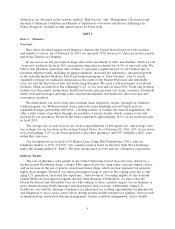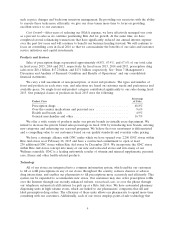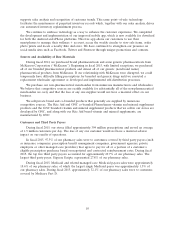Rite Aid 2015 Annual Report Download - page 14
Download and view the complete annual report
Please find page 14 of the 2015 Rite Aid annual report below. You can navigate through the pages in the report by either clicking on the pages listed below, or by using the keyword search tool below to find specific information within the annual report.respectively. However, our earnings were insufficient to cover fixed charges and preferred stock
dividends for fiscal 2013, 2012, and 2011 by $14.0 million, $412.4 million and $564.8 million,
respectively.
Our high level of indebtedness will continue to restrict our operations. Among other things, our
indebtedness will:
• limit our flexibility in planning for, or reacting to, changes in the markets in which we compete;
• place us at a competitive disadvantage relative to our competitors with less indebtedness;
• render us more vulnerable to general adverse economic, regulatory and industry conditions; and
• require us to dedicate a substantial portion of our cash flow to service our debt.
Our ability to meet our cash requirements, including our debt service obligations, both now and
after the completion of the pending acquisition of EnvisionRx, is dependent upon our ability to
substantially improve our operating performance, which will be subject to general economic and
competitive conditions and to financial, business and other factors, many of which are beyond our
control. We cannot provide any assurance that our business will generate sufficient cash flow from
operations to fund our cash requirements and debt service obligations.
We believe we have adequate sources of liquidity to meet our anticipated requirements for working
capital, debt service and capital expenditures through fiscal 2016 (including following the acquisition of
EnvisionRx) and have no significant debt maturities prior to January 2020. However, if our operating
results, cash flow or capital resources prove inadequate, or if interest rates rise significantly, we could
face liquidity constraints. If we are unable to service our debt or experience a significant reduction in
our liquidity, we could be forced to reduce or delay planned capital expenditures and other initiatives,
sell assets, restructure or refinance our debt or seek additional equity capital, and we may be unable to
take any of these actions on satisfactory terms or in a timely manner. Further, any of these actions may
not be sufficient to allow us to service our debt obligations or may have an adverse impact on our
business. Our existing debt agreements limit our ability to take certain of these actions. Our failure to
generate sufficient operating cash flow to pay our debts or refinance our indebtedness could have a
material adverse effect on us.
Borrowings under our senior secured credit facility are based upon variable rates of interest, which could
result in higher expense in the event of increases in interest rates.
As of February 28, 2015, $2.7 billion of our outstanding indebtedness bore interest at a rate that
varies depending upon the London Interbank Offered Rate (‘‘LIBOR’’). Borrowings under our Second
Lien facilities Tranche 1 Term Loan due August 2020 and Tranche 2 Term Loan due June 2021 are
subject to a minimum LIBOR floor of 100 basis points. Borrowings under our senior secured revolving
credit facility are most sensitive to LIBOR fluctuations because there is no floor. If LIBOR rises, the
interest rates on outstanding debt will increase. Therefore an increase in LIBOR would increase our
interest payment obligations under those loans and have a negative effect on our cash flow and
financial condition. We recently increased our borrowing capacity under our senior secured credit
facility from $1.795 billion to $3.0 billion (or $3.7 billion upon the repayment of the $650 million
aggregate principal amount outstanding under our 8.00% senior secured notes due August 2020 (our
‘‘8.00% Notes’’)), which could increase our exposure to this risk. We currently do not maintain hedging
contracts that would limit our exposure to variable rates of interest.
14
























